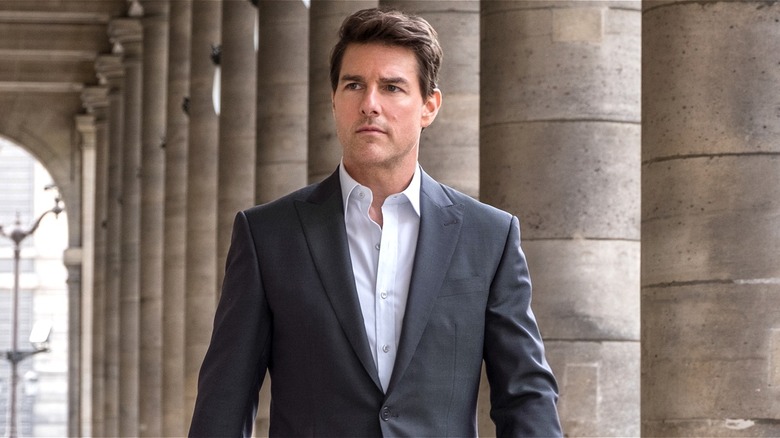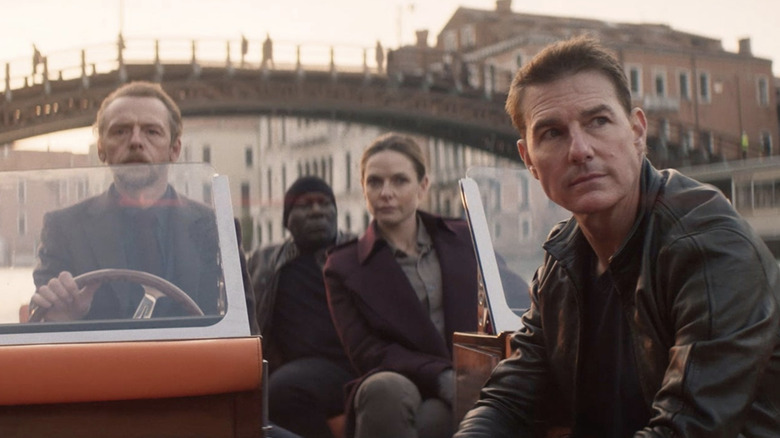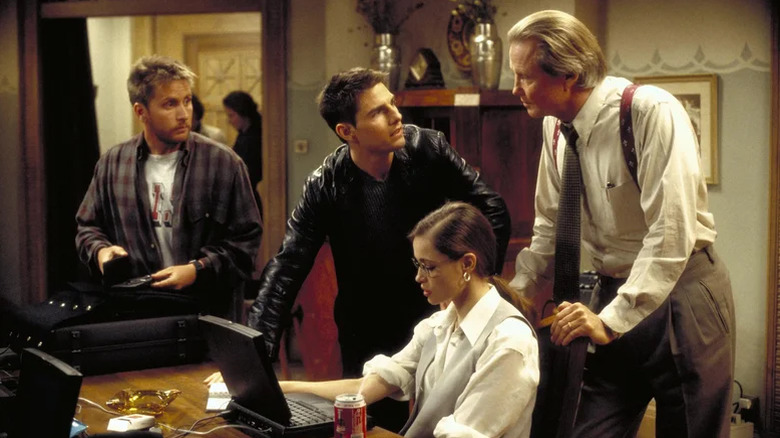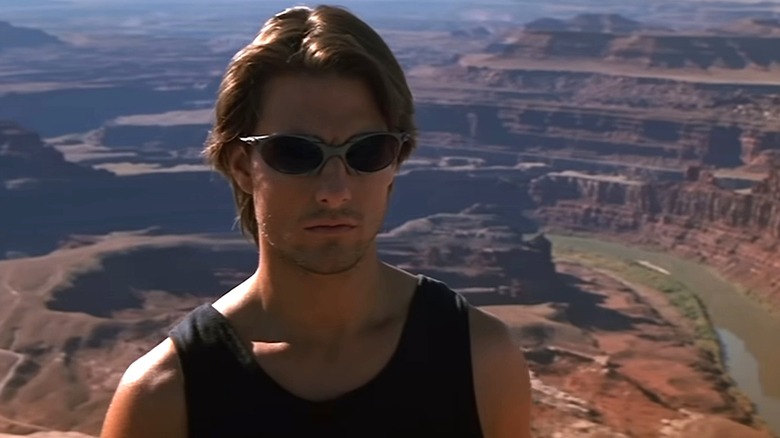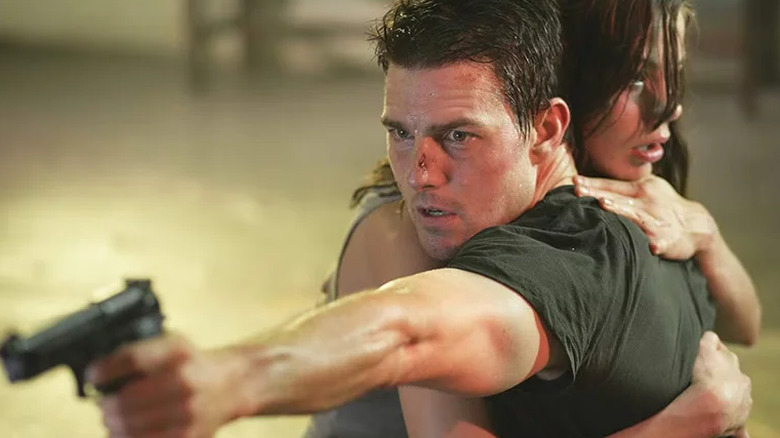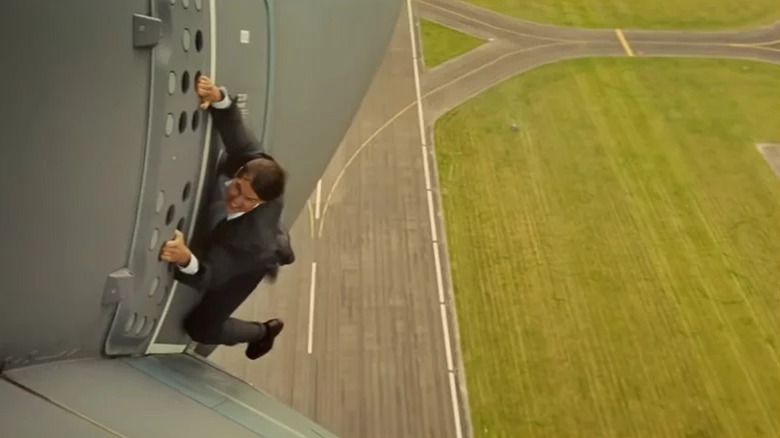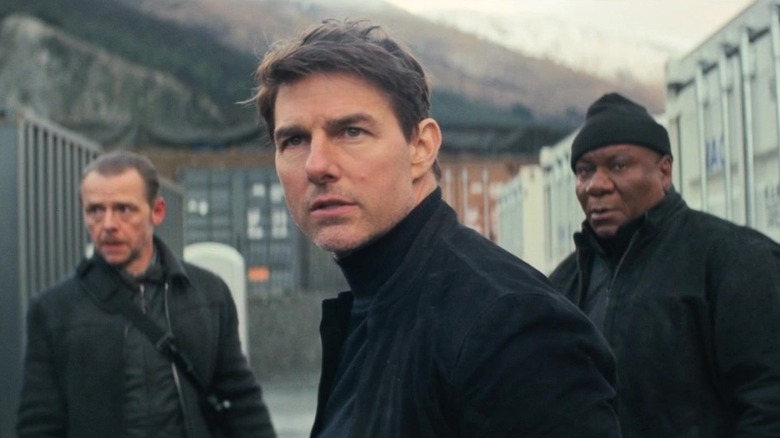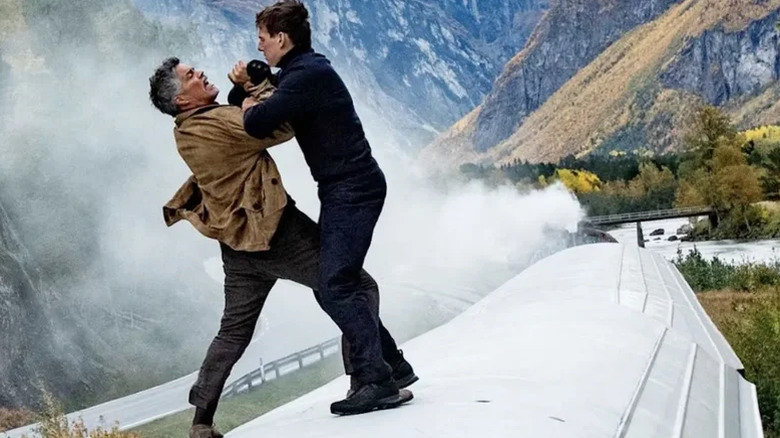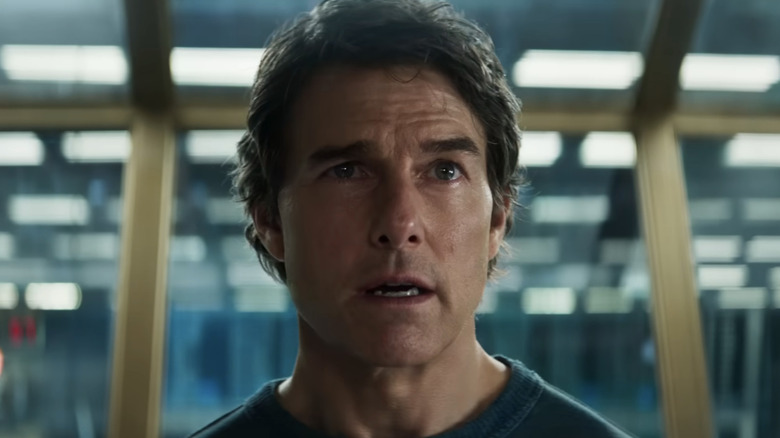How To Watch The Mission: Impossible Movies In Order
There isn't another action franchise quite like the "Mission: Impossible" movies. Sure, the movies are exciting, engaging, and leave behind a serious impact when the credits roll, but there's really one reason that so many of us flock to each new installment. Nowhere else can you see Tom Cruise perform the most dangerous "Mission: Impossible" stunts on-screen — stunts that always live up to the franchise's name. But even if Ethan Hunt wasn't constantly throwing himself from one death-defying experience into another, he'd still be an action hero well worth rooting for. If you have yet to truly commit yourself to the entire franchise, the question you may ask is, "What order should I watch these movies in?" Luckily, the answer is fairly straightforward.
It turns out that the best way to watch the "Mission: Impossible" movies is chronologically, by release order. Thankfully, there are no extra prequels or out-of-order sequels to this franchise. While the movie series was inspired by the original "Mission: Impossible" television series, the films are not related to that series at all, with one minor exception that we'll get to in a moment. However, you can rest easy knowing that you don't have to revisit the spy show unless you really want to. In this case, your best bet is to start with the first film and go from there. The order is as follows:
- "Mission: Impossible" (1996)
- "Mission: Impossible 2" (2000)
- "Mission: Impossible III" (2006)
- "Mission: Impossible – Ghost Protocol" (2011)
- "Mission: Impossible – Rogue Nation" (2015)
- "Mission: Impossible – Fallout" (2018)
- "Mission: Impossible – Dead Reckoning" (2023)
- "Mission: Impossible – The Final Reckoning" (2025)
With this order in mind, let's jump into why "Mission: Impossible" is best viewed in the franchise's chronological/release order.
Why is this the best way to watch the films?
So, why do you need to start at the beginning when watching the "Mission: Impossible" movies? Well, while many of the first few installments can exist as standalone adventures (and are easily enjoyed as such), the deeper into the franchise you get, the more compounded the plot becomes. For example, one may not need to watch "Mission: Impossible 2" to better understand "Mission: Impossible – Fallout," as neither film is connected beyond sharing members of the main cast, and the plots don't exactly overlap. However, you would be quite confused during the third act of "Fallout" if you hadn't seen "Mission: Impossible III" beforehand since the third film directly impacts the sixth movie's story. It's true that not every Ethan Hunt adventure connects directly to the one before, but with each new mission, Hunt's world seems to get smaller and smaller.
Additionally, to better appreciate some of the long-term character development of the franchise's supporting cast — namely Benji Dunn (Simon Pegg), Luther Stickell (Ving Rhames), and Ilsa Faust (Rebecca Ferguson) — it's best to start at the very beginning of the Impossible Mission Force's (IMF) time together. Even if they weren't all introduced right up front, they've been around long enough that the earliest installments still matter.
Finally, seeing the way that Ethan himself has grown since the very first film and how he's learned from his previous mistakes is paramount to better understanding and appreciating the entire "Mission: Impossible" timeline. Plus, it's just fun to watch how Tom Cruise has grown as an actor over the years — and how increasingly willing he is to perform explosive stunt after explosive stunt for the cameras.
Mission: Impossible (1996)
When watching the very first "Mission: Impossible" film, it's important to note that the Brian De Palma-directed movie is a reboot (or, maybe the best term is a "reimagining") of the classic television series. The original "Mission: Impossible" program ran from 1966 until 1973, and a sequel series aired between 1988 and 1990. However, as we noted before, the TV shows are not required viewing when watching the Tom Cruise movies, even if the Jim Phelps character crosses over to the film franchise. Additionally, because Jon Voight replaces Peter Graves as Phelps on the big screen, the actual continuity between the two franchises is a bit murky anyway. That said, the 1996 "Mission: Impossible" film is where you'll want to start.
Here, we see that Ethan Hunt learned everything he knows about espionage from Jim Phelps, who is both a mentor and a father figure to the younger IMF agent. When his entire team is killed in a mission gone wrong, the blame is placed on Ethan, who must clear his name at all costs. This leads him to work with Ving Rhames' Luther Stickell, and "Mission: Impossible" history is born. While the film doesn't fully explore Ethan's reasons for joining the IMF, it effectively serves as an origin story for the character as he learns to become a leader in his own right, fighting for global security even if he does so (mostly) alone. It's a bit '90s compared to some of the more recent installments, but it just shows how long Ethan has been at the IMF game.
Mission: Impossible 2 (2000)
Set a few years after the events of the first film, Ethan Hunt is now working under Mission Commander Swanbeck (Anthony Hopkins) as he is thrown into a new adventure in "Mission: Impossible 2." In step with the episodic nature of the television series that inspired it, this sequel bears few direct connections to the first film and is largely a standalone mission full of new twists and turns. Of course, Luther returns here (as he does in every "Mission: Impossible" film), but otherwise this is a slight veer off course. In the 2000 sequel, Ethan is paired with a thief named Nyah Nordoff-Hall (Thandiwe Newton) to steal back a weaponized disease from a former IMF agent named Sean Ambrose (Dougray Scott), who has betrayed his country.
Directed by John Woo, "Mission: Impossible 2" is often considered the worst film in the franchise, but it's a fun action flick in its own right. While it's probably the one with the least amount of connections to the larger franchise's picture, it is still full of plenty of action and at least one powerful twist that audiences won't see coming. Of course, the biggest reason to watch this installment is because it's home to a stunt that Tom Cruise begged John Woo to let him attempt, one that would set "Mission: Impossible" precedent for sequels to come. In short, don't be tempted to skip "Mission: Impossible 2." It's a bit dated and doesn't hold up as well as the first film by comparison, but there are moments here that are well worth your time.
Mission: Impossible III (2006)
"Mission: Impossible III" is where the franchise really begins to take a serious turn for the better. Not that the previous two films are bad, but this is where the spy franchise finds its unique, action-packed voice. Hot off of "Alias," J.J. Abrams directed the third feature-length Ethan Hunt adventure, which is far more dangerous (and personal) than ever before. Having retired from the IMF to settle down with the love of his life, Julia Meade (Michelle Monaghan), Ethan tries leaving the whole "saving the world" thing behind. Unfortunately, his past catches up to him pretty quickly. When a new villain, arms dealer Owen Davian (Philip Seymour Hoffman), arrives on the scene, he's hoping to secure the mysterious "Rabbit's Foot" device, and Ethan is pulled back into the world of espionage as his personal reality falls apart.
Of all the "Mission: Impossible" flicks, the third film is arguably the franchise at its most emotionally intense. As Ethan, Luther, and a new team (which introduces Simon Pegg's Benji Dunn to the franchise) track down the Rabbit's Foot (and Davian, by proxy), they quickly discover that none of them are safe from the villain's wrath. "Mission: Impossible III" shows us the true cost of Ethan's work with the IMF and how it infiltrates every aspect of his life. It also gives him a greater emotional connection to the IMF agency and his fellow operatives. Though Abrams didn't direct another "Mission: Impossible" installment after this one, he remained a producer on the franchise for the next three sequels.
Mission: Impossible - Ghost Protocol (2011)
Picking up several years after the third film, "Mission: Impossible – Ghost Protocol" changes the franchise in more ways than one. For starters, gone are the days of number-based sequel titles; from now on, each new mission gets its own clever subtitle to go with it. "Ghost Protocol" also introduces Jeremy Renner's William Brandt, a dual foil and ally to Ethan Hunt on his most recent mission to clear his name after being framed, this time for bombing the Kremlin. Yes, Ethan is on the run again, but this time, Ghost Protocol is initiated to help our heroes along. Having been publicly disavowed by their country, Ethan, Benji, Brandt, and the one-and-done addition of Jane Carter (Paula Patton) work under secret IMF orders to find the terrorists responsible, taking them all over the world in the process.
"Mission: Impossible – Ghost Protocol" features some of the coolest scenes in the franchise's history, including Ethan's notorious climb of the Burj Khalifa skyscraper in Dubai and the opening Moscow prison break sequence that will make Dean Martin's "Ain't That a Kick in the Head" get stuck in your brain for hours. Directed by Brad Bird ("The Iron Giant"), "Ghost Protocol" is pretty standalone in both style and narrative content, but it does contain many direct connections to both its immediate predecessor and sequel. Also, it's a shame that Jeremy Renner left the "Mission: Impossible" franchise so soon (he would stick around only until the next film) because Brandt is just full of potential. With this film, released in 2011, the "Mission: Impossible" series began to film and debut installments more frequently, and individual plotlines started to come together and build into larger problems for the IMF.
Mission: Impossible - Rogue Nation (2015)
The first installment to be directed by Christopher McQuarrie, "Mission: Impossible – Rogue Nation" introduces a mysterious intelligence agency known only as The Syndicate, a group of former intelligence operatives assembled by former MI6 operative Solomon Lane (Sean Harris). Lane would become the first recurring villain of the franchise, and it's here in "Rogue Nation" that he finds himself on Ethan Hunt's radar. Additionally, the fifth installment is also the first to add Rebecca Ferguson's Ilsa Faust to the mix, another former MI6 agent who quickly catches Ethan's eye, and the last Jeremy Renner appearance to date. After the IMF is set to be absorbed by the CIA, Ethan, Luther, Benji, and Brandt team up with Ilsa to save their agency — and the world — before the Syndicate's plan goes into effect.
As explosive as ever, "Mission: Impossible – Rogue Nation" is a thrill from start to finish, and while Ethan Hunt should have died while clinging tightly to the side of a cargo plane, he does survive. Yes, Tom Cruise actually did this stunt for real, and it makes our hearts beat all the faster knowing that the actor was holding on for dear life for the stunt's entire shoot. Again, the "Mission: Impossible" films can be enjoyed based on Tom Cruise's stunts alone, but it helps that "Rogue Nation" is a powerfully crafted action flick that keeps the audience thoroughly engaged until the end. Just be sure to breathe as Tom Cruise, err, Ethan Hunt, makes his way inside the plane.
Mission: Impossible - Fallout (2018)
Arguably the best film in the "Mission: Impossible" franchise, "Mission: Impossible – Fallout" proves that stories like these work far better when everything matters. While not every previous installment is referenced here, "Fallout" calls back to the 1996 film, the third installment, and the previous two sequels as Ethan Hunt and his IMF team find themselves battling against Solomon Lane once more —only this time, they're not alone in their mission. Due to previous disagreements with other government agencies, the CIA assassin John Walker (Henry Cavill) is added to Ethan's detail, and he proves himself a deadly threat to whoever stands in his way. As Lane has formed his new terrorist group, the Apostles, it's up to Ethan and the others to stop him for good before he can start a global catastrophe from which the world may never recover.
Featuring some of the most explosive action in the series, "Mission: Impossible – Fallout" is a tour de force of spy-themed entertainment. Not only is each action sequence top-notch, but Ethan's own conflicted arc throughout the film echoes some of Cruise's earlier work in the series. With more at stake than ever, both personally and professionally, "Fallout" is quite accurately named, though it's essentially "Rogue Nation – Part Two." Of course, the sixth installment takes care to ensure that the audience never feels behind. By the time you get to the end of "Mission: Impossible - Fallout," you'll almost wish for more, despite the two-and-a-half-hour runtime.
Mission: Impossible - Dead Reckoning (2023)
The third sequel directed by Christopher McQuarrie, the franchise's seventh installment was originally titled "Mission: Impossible – Dead Reckoning, Part One" upon its theatrical release. However, the film has since been renamed to simply "Mission: Impossible – Dead Reckoning." But don't let the title shift fool you; "Dead Reckoning" still feels like the first half of a larger whole that is not complete without its sequel. Set an unknown number of years after "Fallout," this film pits Ethan Hunt and his IMF team against the entire world as Ethan, Benji, Luther, and Ilsa go off-book to find a mysterious, two-piece cruciform key that can control an even more mysterious artificial intelligence known only as "The Entity." Unfortunately, this cyber-terrorist knows the darkest secrets of Ethan's past.
While "Mission: Impossible – Dead Reckoning" has plenty of confusing moments, the film is actually meant to feel somewhat off as Ethan battles an enemy who cannot be fully known or understood. There is no fight between Ethan and the Entity, though the A.I. gets as close as it can through its assassin, Gabriel (Esai Morales), who performs double duty as both the Entity's human emissary and a villain from Ethan's formative years. Yes, more information about Ethan's pre-IMF life is teased here, but the audience only gets more questions with very few answers. As Ethan is joined by newcomer Grace (Hayley Atwell), "Dead Reckoning" begins a ride that it cannot finish despite its extensive runtime, leaving that up to the next sequel.
Mission: Impossible - The Final Reckoning (2025)
The eighth installment of the "Mission: Impossible" franchise and Christopher McQuarrie's fourth adventure with Ethan Hunt, "Mission: Impossible – The Final Reckoning" was subtitled "Dead Reckoning, Part Two" before the title shift. However, we have to admit that the new title sounds infinitely cooler. Still reeling from the events of the previous film (and relishing their small victories), Ethan, Grace, and the IMF crew continue their mission against the mysterious Entity A.I., with their quest taking them all over the world as they try to keep it out of the wrong hands. "Our lives are the sum of our choices," Ethan says, so it's no wonder that "The Final Reckoning" takes a peek behind the curtain at the iconic superspy's life before joining the IMF as he embarks on this impossible journey.
With a cast featuring more returning characters than ever, "The Final Reckoning" may (or may not) be the final "Mission: Impossible" chapter. Though McQuarrie has stated that there are more Ethan Hunt stories to be told, however you look at it, "The Final Reckoning" should be chock full of Tom Cruise action that can't be found anywhere else. As the past continues to catch up with Ethan, everything is on the line as the IMF fights to defeat their only non-human opponent, one who will hold no remorse if it ends up destroying the world. If you want to fully understand the weight of "Mission: Impossible – The Final Reckoning," then it's crucial that you watch each "Mission: Impossible" movie in chronological/release order. That way, it will all come down to this.
